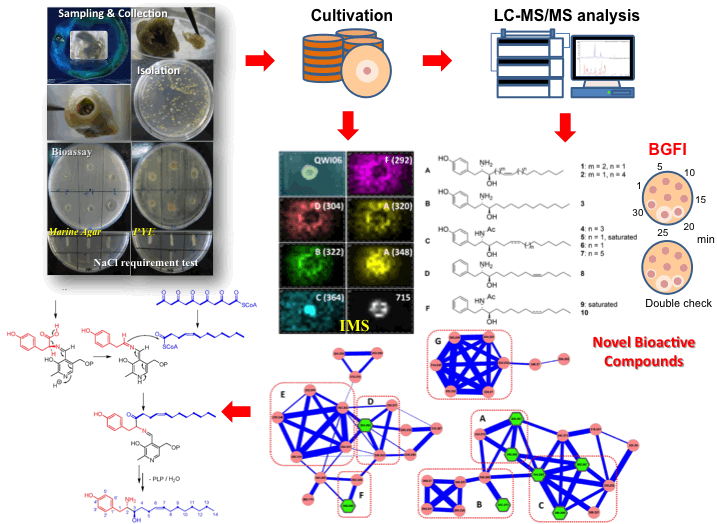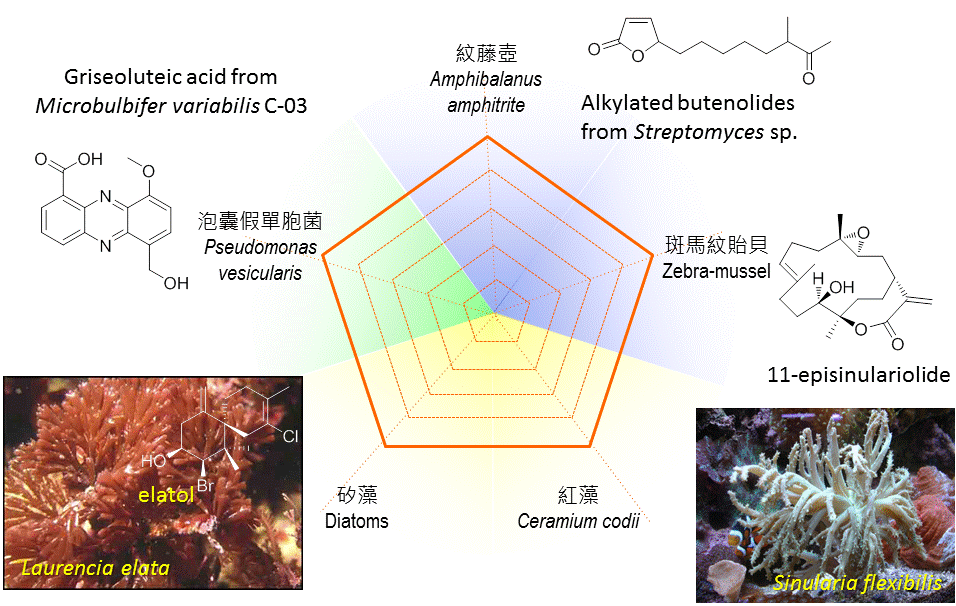|

Research Overview
Natural products
consistently provide unmatched molecular structural diversity for drug
discovery in the pharmaceutical view. The oceans cover 70% of the Earth’s
surface and harbor most of the planet’s biodiversity, which have received
considerable attention as a resource for natural product discovery. Taiwan,
surrounded by Taiwan Strait and Pacific Ocean, possesses abundant marine
resources. Searching new bioactive principles from the unique Taiwanese
resources by an efficient strategy is emergency and important for Taiwan
biotechnology and pharmaceutical industries in future.
a) Establishing
the de-replication strategy on rapidly searching novel bioactive natural
products from marine microbes
De-replication by modern
analytical instruments, such as NMR and LC-MS/MS, has become a popular and
powerful strategy for natural products research, especially, based on the
established/commercial chemical database, such as Scifinder, MarinLit/Antimarin,
and so on. Although these databases are very helpful for the identification
of natural products to save time, scientists still need to put a lot of
efforts in the time- and cost-consuming natural products isolation process
to confirm their research results, accompanied with such de-replication
process. On the other hand, following the advances of modern mass spectral
analysis, the molecular networking analysis generated by the MS/MS data of
microbial metabolites from colonies (without extraction) can successfully
distinguish different groups of peptide compounds for studying microbial
interaction and metabolomics. Furthermore, we also found this can also be
used on the identification and grouping of small molecular metabolites of
microbes. In the proposal, we would like to propose a new strategy on
rapidly searching novel bioactive compounds from natural sources by using
chemotype identification of microbes, peak library establishment and
molecular networking analysis, coupling with bioactivity-guided
fractionation isolation and spectral/chemical databases de-replication
process. At the mean times, by the strategy mentioned above, we would like
to explore the novel secondary metabolites of deep-sea marine microbes, such
as Genera Bacillus and Streptomyces, and microbial symbionts, such as Genera
Microbulbifer and Pseudovibrio, of marine invertebrates from the unexplored
waters of Taiwan and investigate their anti-microbial and anti-cancer
activities.

The work flowchart to
search bioactive components from marine microbes.
Relevant Research Projects
1. The study on the antibiotic and
anti-inflammatory secondary metabolites from marine micro-organisms,
supported by the grant from National Science Council (自海洋微生物獲取具抗生活性之天然產物,NSC
101-2320-B-110 -001).
2. The study on the secondary metabolites
from marine microorganisms and their modified analogues to inhibit
opportunistic pathogens, supported by the grant from National Science
Council (研究海洋微生物二次代謝物及其衍生物在抑制伺機性病菌之作用,NSC
102-2320-B-110 -002).
3. The study on establishing the strategy
on rapidly searching novel bioactive natural products from marine microbes
by molecular networking, supported from Ministry of Science and Technology
(利用質譜分子網絡等工具建立快速尋找新型海洋微生物活性天然產物之策略,MOST103-2628-B-110-001-MY3).
4. The researches on the marine natural
products with anti-microbial, anti-virual, and cytotoxic activities from
symbiotic microbes in marine invertebrates
(自海洋無脊椎共生微生物開發抗菌、抗病毒與細胞毒殺海洋活性天然物研究, MOST
105-2320-B-110 -002 -MY3)
b) Study on Marine Microbial
Ligands to complex with trace metals
Trace metals play the
important role in the growth of organisms on Earth, such as the redox
centers of various enzymes. The trace metals all occur in picomolar to
nanomolar quantities in the world’s oceans. Marine microorganisms are
presented with unique challenges to obtain essential metal ions required to
survive and thrive in the ocean. The production of organic ligands to
complex transition metal ions is one strategy to both facilitate uptake of
specific metals, such as iron, and to mitigate the potential toxic effects
of other metal ions, such as copper.
Taiwan is an island with high mountains and rivers cross the
mountain areas, which take large amount rock and sand into ocean in seasons
of falling rain. In addition, steel-slag disposal make unusual distributions
of certain trace metals in Taiwan Strait. All of these phenomena affect the
life cycle and distribution of marine microorganisms. In the proposal, we
plan to decipher the chemical structures of organic ligands from the marine
microorganisms and to clarify the metal speciation of these ligands and
their bioavailability, which will be helpful for us to understand how
ligands bind with and control metal speciation and cycling within the
Earth's oceans.
Relevant Research Projects
1. The study on the secondary metabolites
from marine microbes as marine ligands to complexe with trace metals,
supported by the grant from National Science Council
(海洋微生物所產之二次代謝物做為海洋配體對微量金屬之螯合作用研究,NSC 102-2611-M-110
-008).
2. The study on elucidating the
relationship between trace metal and molecular networking, supported by the
grant from Ministry of Science and Technology, supported from Ministry of
Science and Technology (以海洋微生物代謝物分子網路建立其海洋配體與海洋微量金屬之關係,MOST
103-2611-M-110-006).
3. The analysis of marine ligands from
marine mircoorganism to chelate the trace metals on water in southern
Taiwan, supported from Ministry of Science and Technology
(台灣南部海域海洋微生物產螯合微量金屬之海洋配體分析,MOST 104-2611-M-110-021).
c) Evaluation and Development of
Marine Antifouling Agents
Biofouling is the
accumulation of marine organisms, including bacteria, algae, mollusks,
polychaetes, ascidians, and barnacles on wetted surfaces of vessels and
other man-made structures, which usually associate corrosions and damages.
Since tributyl-tin (TBT) was globally banned in 2008 for its irreversible
adverse effect on marine life, it is urgent for scientists to discover
novel, effective and environmental-friendly antifouling agents. We have
found several natural-occurring chemicals with antifouling activities from
marine microorganisms, marine invertebrates, and terrestrial plants by
testing on established bioassays, including antimicrobial, anti-biofilm
forming and anti-barnacle settlement assays. Based on our preliminary
results, we expect to discover more chemical agents with similar structural
skeletons (pharmacophores) from various resources or synthesize their
analogues for further bioassay screening. This study will offer more
compounds with antifouling activities as options to apply in the
paint/coating industries. All in all, the aim of this project is to search
novel antifouling candidate agents from secondary metabolites of multiple
sources based on the skeletons of compounds with known antifouling
activities.

Searching a complex formula
of anti-fouling agents.
Relevant Research Project
1. Evaluation and Development of
Antifouling Agents,
supported by the grant from YUNG CHI PAINT & VARNISH MFG. CO.,LTD (NSC
101-2320-B-110 -001).
d) Study on the Bioactive
Components from Herbal Medicine
Secondary
metabolites, namely natural products, are the chemical compounds of
metabolism that are not essential for normal growth, development or
reproduction of an organism. Secondary metabolites should also include
products of overflow metabolism as a result of nutrient limitation, or shunt
metabolites produced during idiophase, defense mechanisms, regulator
molecules, and so on. These metabolites also present multifunctions in the
bodies of life organism, such as the signal transmitter.
Based on our previous experience on the studies
of bioactive compounds of folk medicines, we set two aims;
1. to isolate and purify the bioactive
components or lead compounds of TCM / folk medicine (herb) / marine
organisms by bioactivity-guided fractionation isolation, such as anti-cancer
(cytotoxicity), anti-inflammatory effect, anti-diabetes, and so on. We also
try to investigate the mechanism of actions of bioactive compounds or the
modified analogues of lead compounds.
2. to investigate the bioactive compounds from
TCM tonics to induce (manipulate) the “directed” differentiation of
embryonic stem (ES) cells to promote the application of natural products or
herb medicine in the regenerative medicine in the future.
Relevant Research Projects
1. The
study of anticancer components from Pterocarpus indicus wild,
supported by the grant from National Science Council,
2005,08,01-2006,07,31 (NSC94-2320-B-041-011).
2. The
research on the anticancer and anti-inflammatory components of Cannabaceous
plant, Humulus scandens, supported by the grant from National Science
Council, 2006,08,01-2007,07,31 (NSC
95-2320-B-039-052).
3. The
development of cosmetic resources from Traditional Chinese Medicine,
safflower, and relative researches, supported by the grant from National
Science Council, 2006,05,01-2007,04,30 (NSC
95-2622-B-039-001-CC3).
4. The
investigation of functional properities of anti-cancer and anti-inflammatory
components from Taiwanese folk medicine in the pathogenesis of pancreatic
adenocarcinoma, supported by the grant from National Science Council,
2007,08,01-2008,07,31 (NSC
96-2320-B-039-025).
5. The
researches on the anti-inflammatory components from Formosan Folk medicine
and the modification of these bioactive components, supported by the grant
from National Science Council, 2008,08,01-2011,07,31
(NSC
97-2320-B-039-018-MY3).
6. The study on the bioactive substances of Avicenia marina, Sesuvium portulacastrum, and Pittosporum moluccanum in
Pingtung mangrove swamp, supported by the grant from National Science
Council (NSC 100-2320-B-110 -004).
|